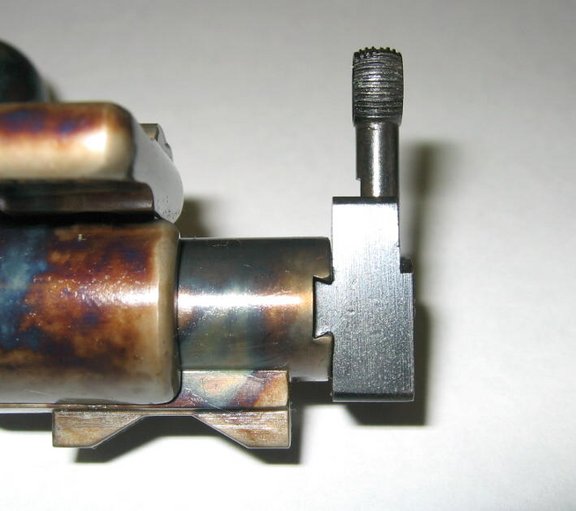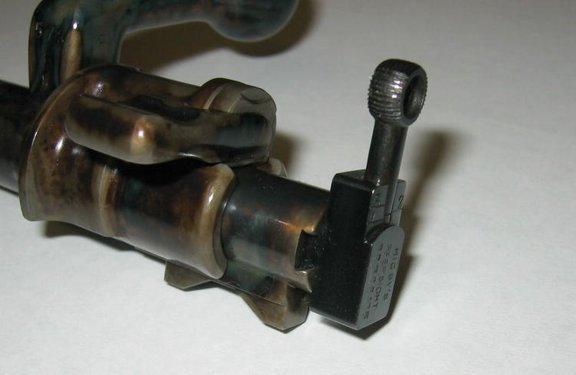

 The Accurate Reloading Forums
The Accurate Reloading Forums  THE ACCURATE RELOADING.COM FORUMS
THE ACCURATE RELOADING.COM FORUMS  Rifles
Rifles  Medium Bore Rifles
Medium Bore Rifles  Classic sights and scopes?
Classic sights and scopes?Go  | New  | Find  | Notify  | Tools  | Reply  |  |
| one of us |
Thank you guys in advance for all the help that you have given me both in the past and in the future. Also if they become to tiresome, just ignore and please don't pound me to death as they do to some on some other boards. I believe that most classics had hooded front sights with a bead. The rear sights were predominantly two or more folding V sights. These were sighted in at the factory and regulated for the ammunition sold by the factory. It was good-to-go. A customer could buy a rifle, ammo and go hunting without worrying about sighting it in. Have I got this right? I have never seen British classics using peep sights. They are so common in the U.S. and better in my opinion. Any one have an idea why this might be? In reading one of Corbett's book, his doctor friend used a scope. I believe this was before WWII or right after. I've seen a picture of a scoped 275 Rigby bought by Bell in the mid 20s. How common were scopes in this time frame? Also, I assume that they were on those high mounts because they were somewhat unreliable. Have I got this right? Thanks again captdavid "It's not how hard you hit 'em, it's where you hit 'em." The 30-06 will, with the right bullet, successfully take any game animal in North America up to 300yds. Get closer! | ||
|
| One of Us |
219 of John Speeds book shows a 275 High Velocity Rigby Mauser with a peep site on rear portion of the bolt, and it is hooded with band front site with interval rear site island with two leafs. This is Rigby son 5434 and Mauser sn 66919. It was built in 1912. I have seen two such rifles in person. The safety is of the wing type with safe ingn gold. This is in the chapter titled The Popular 275 Rigby. This may not be every mans Rigby, but is what I picture when someone says Rigby 275. Rigby also used an express sight with a flip up ladder set to 1000 yards. This is shown on page 217. There is whole chapter on inter war scopes and mounts. Zeiss is very well respected in the chapter. You need the pages to see the different reticle so mounts. There are saddle quick detach one piece units and claw dovetail units. During this period these Mauser mounts are of the raised see through type for iron sites. As such the scope is very high with. Especially, with the drop at the heel and toe of the Mauser stock. See pages 172 through 174. There is a Rigby advert published on page 213. With what looks like two piece dovetail Masuer rings and Zies scope from the chapter on interwar scopes. The advertisement does not give make or model of scope or rings. It is a dovetail as it shows ghost lines of the scope being swung off. The rifle in the adver is shown on page 215 a 400/350 with scope on. This is Rigby sn 3597. It has Masuer serial number 22258. It has an integral site island with hooded but no band front site. There is one standing and two folding leafs. page 215. The front scope ring is mounted on the barrel shank. In this text the mounts are described as Rigby hook type. But they look like the Masuer in the scope and mount chapter. Hope this helps, let me know if it does not. I cannot upload pics, but could text them. I think for your build you need these pictures. | |||
|
| one of us |
Thanks, captdavid "It's not how hard you hit 'em, it's where you hit 'em." The 30-06 will, with the right bullet, successfully take any game animal in North America up to 300yds. Get closer! | |||
|
| One of Us |
Rigby made a couple different types off cocking piece mounted peeps that I'm aware of. The early ones had a post that was locked in place with a screw. The other used an adjustable diopter wheel. NECG may have a couple of the Prechtle versions of the diopter type in stock. I bought one from them a few years ago. Matt FISH!! Heed the words of Winston Smith in Orwell's 1984: "Every record has been destroyed or falsified, every book rewritten, every picture has been repainted, every statue and street building has been renamed, every date has been altered. And the process is continuing day by day and minute by minute. History has stopped. Nothing exists except an endless present in which the Party is always right." | |||
|
| One of Us |
All of the British makers offerd peep sights on their Mausers. Rigby and W.J. Jeffery both had their own patented cocking piece peep sights and other makers often used a Lyman modified to dovetail into the bolt cocking piece. I'm thinking Westley Richards had some special sight too but can't remember. They did scope a lot of rifles though even offering them on doubles. Holland and Holland had a staff peep that folded back down into a recess in the top strap on singles and doubles - not sure if they peep sighted very many Mausers though. Jeffery even put Lyman peep sights on their 450/400 Farquharsons! | |||
|
| One of Us |
I'm certainly not a Mauser expert like some here but sighting equipment seems also to be somewhat country specific. The Brits for example favored the shallow V while Americans moved to the peep sight during that period of time. In other words people tend to use what they see their fellow countrymen use. Regarding the scopes sight, one other reason for the high mounts is to clear the Mauser wing safety that has to swing over the top. Improvements in optics especially after WWI started the slow migration to scopes. As this happened mounts became lower as the reliability improved and the need to use open sights for backup diminished. P.S. Captdavid, I for one enjoy the questions you are raising. It really has brought out some good responses for from folks who know their stuff. All this Mauser history I find pretty fascinating. Roger ___________________________ I'm a trophy hunter - until something better comes along. *we band of 45-70ers* | |||
|
| one of us |
I have only owned one that the sights shot to zero, most were off from 3 to 8 inches, usually the vertical was the problem, and that can be ammo or a person eyesight..Always sight in any rifle you intend to shoot, never allow someone else to sight in your rifle, especially a DG rifle. As others stated the old gun makers had peep sights available, and mostly the popular bolt peep, which btw isn't a particularly accurate set up, and takes a skilled hand to make one fit up to work..moving parts in a sight isn't my cup of tea..Give me a shallow V.. Also many sights of the day had peep atachments on the scope bases as they do today. The first one I owned was Redfields Little Bo Peep, I still have a few of those. Keep in mind the old timers of yesteryear for the most part hated peep sights in that they were slow to get on target for hunting, The problem was not the sight but the lack of knowledge to use a bigger hole in the peep that made it the fastest of all iron sights..Same with the scope, it was in its infancy along with the calibers, and the knowledge, but that all came together in about the 1950s when the scopes and Receiver sights gained popularity over the barrel mounted irons..Most all my rifles have scopes and iron sights..Todays shooter, raised with scopes seem to have moved away from the irons, and have a second back up scope, or so it seems to me. The scopes of yesterday were probably more accurate than irons, but the lacked centered reticles and that had to taken up with rings and bases, it was a pain btw..The mounting systems then were more of a problem than the scopes themselves. I may not be totally accurate but I was there and that's was my experience at the time of change where I was, at least partly as the advance of rifles, scopes, etc. took place over quite a number of years. Paul Mauser set the standard for bolt action rifles and is still king today. Ray Atkinson Atkinson Hunting Adventures 10 Ward Lane, Filer, Idaho, 83328 208-731-4120 rayatkinsonhunting@gmail.com | |||
|
| one of us |
Rigby 275 take down    WJ Jeffery: 404 Jeffery Sights Lyman   | |||
|
| one of us |
And inviting one of the two greatest medium game cartridges of all time, the 7x57. Captdavid "It's not how hard you hit 'em, it's where you hit 'em." The 30-06 will, with the right bullet, successfully take any game animal in North America up to 300yds. Get closer! | |||
|
| one of us |
Those just look clunky to me, along with being expensive. I guess I was just born lucky when it comes to scopes. When I first started hunting in the mid 60s, it was the Weaver 4x. Next it was the Redfield widefield variable, and on from there. I have never had a scope fail and had to go to a backup. I have had loose mounts, twice, but now I always check. I have decided to go with a double flip-up ramp. KISS it. Thanks for the help, Captdavid For those who don't know: KISS = Keep It Simple Stupid "It's not how hard you hit 'em, it's where you hit 'em." The 30-06 will, with the right bullet, successfully take any game animal in North America up to 300yds. Get closer! | |||
|
| One of Us |
The reason scopes were mounted so high pre-World War II was twofold: the makers felt the need to offer the option of iron sights to the shooter, without his having to dismount the scope, and the scope had to be that high to clear an unmodified bolt. Noske and Lyman solved the latter problem by offering scopes with eye relief long enough that they could be mounted far enough forward to clear the unaltered bolt, and the advantages of a low mounted scope became evident. | |||
|
| Powered by Social Strata |
| Please Wait. Your request is being processed... |
|
 The Accurate Reloading Forums
The Accurate Reloading Forums  THE ACCURATE RELOADING.COM FORUMS
THE ACCURATE RELOADING.COM FORUMS  Rifles
Rifles  Medium Bore Rifles
Medium Bore Rifles  Classic sights and scopes?
Classic sights and scopes?

Visit our on-line store for AR Memorabilia

